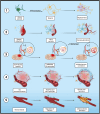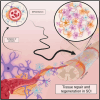Physiological Insights Into the Role of Pericytes in Spinal Cord Injury
- PMID: 39757951
- PMCID: PMC11701711
- DOI: 10.1002/jcp.31500
Physiological Insights Into the Role of Pericytes in Spinal Cord Injury
Abstract
Vascular regeneration plays a vital role in tissue repair yet is drastically impaired in those with a spinal cord injury (SCI). Pericytes are of great significance as they are entwined with vessel-specific endothelial cells and actively contribute to maintaining the spinal cord's vascular network. Within the neurovascular unit (NVU), subtypes of pericytes characterized by various markers such as PDGFR-β, Desmin, CD146, and NG-2 are involved in vascular regeneration in SCI repair. Various pericyte signaling, pericyte-derived exosomes, and endothelial-pericyte interplay were revealed to participate in SCI repair or fibrotic scars. Through further understanding pericyte biology, it is aimed to accurately generate subtypes of pericytes and develop their therapeutic potential. This review focuses on recent advanced research and development of pericytes as a potential treatment for SCI.
Keywords: pericyte; physiology; spinal cord injury.
© 2025 The Author(s). Journal of Cellular Physiology published by Wiley Periodicals LLC.
Conflict of interest statement
The authors declare no conflicts of interest.
Figures


Similar articles
-
Versatile subtypes of pericytes and their roles in spinal cord injury repair, bone development and repair.Bone Res. 2022 Mar 16;10(1):30. doi: 10.1038/s41413-022-00203-2. Bone Res. 2022. PMID: 35296645 Free PMC article. Review.
-
Pericytes Act as Key Players in Spinal Cord Injury.Am J Pathol. 2019 Jul;189(7):1327-1337. doi: 10.1016/j.ajpath.2019.03.008. Epub 2019 Apr 20. Am J Pathol. 2019. PMID: 31014955 Free PMC article. Review.
-
Pericyte-derived exosomal miR-210 improves mitochondrial function and inhibits lipid peroxidation in vascular endothelial cells after traumatic spinal cord injury by activating JAK1/STAT3 signaling pathway.J Nanobiotechnology. 2023 Nov 27;21(1):452. doi: 10.1186/s12951-023-02110-y. J Nanobiotechnology. 2023. PMID: 38012616 Free PMC article.
-
Proliferating NG2-Cell-Dependent Angiogenesis and Scar Formation Alter Axon Growth and Functional Recovery After Spinal Cord Injury in Mice.J Neurosci. 2018 Feb 7;38(6):1366-1382. doi: 10.1523/JNEUROSCI.3953-16.2017. Epub 2017 Dec 26. J Neurosci. 2018. PMID: 29279310 Free PMC article.
-
Asiaticoside Attenuates Blood-Spinal Cord Barrier Disruption by Inhibiting Endoplasmic Reticulum Stress in Pericytes After Spinal Cord Injury.Mol Neurobiol. 2024 Feb;61(2):678-692. doi: 10.1007/s12035-023-03605-3. Epub 2023 Sep 1. Mol Neurobiol. 2024. PMID: 37653222
References
Publication types
MeSH terms
LinkOut - more resources
Full Text Sources
Medical
Miscellaneous

